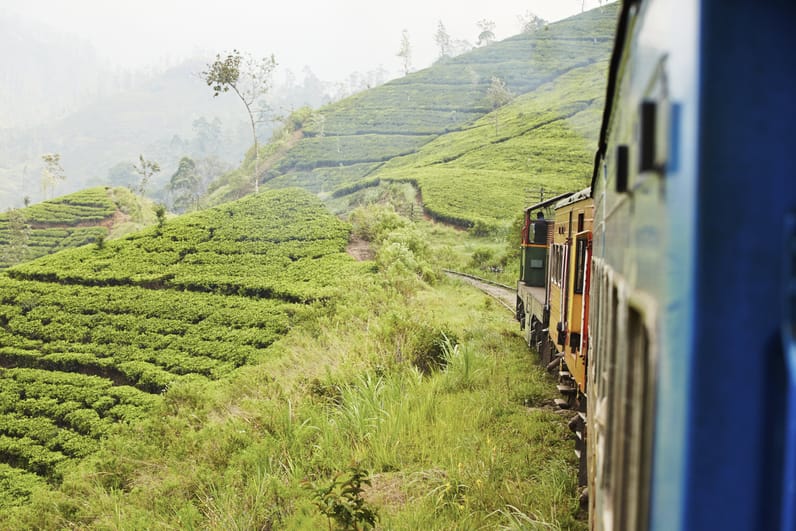Lightfoot Travel
WhatsApp Business Account

At every station people board the rickety timber train, and wander through the carriages selling mango slices, parcels of rice and curry, oranges, spiced chickpeas and lottery tickets. Passengers hang outside the open doorways and when the train goes through the tunnels, the children shriek with delight. I’m travelling east from Sri Lanka capital Colombo, into the picturesque highlands and from the train windows; the dominant colour is a vivid green as far as the eye can see. Lush layers of velvet hug the slopes like a carpet of thick shag, manicured and laid out without a wrinkle.
The hillsides are dotted with specks of bright colour, as squads of sari-clad tea pickers move deftly through the metre-high bushes picking the leaves and buds, and placing them into wicker baskets strapped to their backs. This is tea country – and for 150 years, Ceylon, Sri Lanka’s former name, has been a byword for some of the world’s finest teas, unrivalled in flavour and aroma.
Slap bang in the middle of the tea-growing region at an altitude of 1,868 metres is Nuwara Eliya, which retains its hill station atmosphere more than anywhere else in the country. Once the favoured stomping ground for tea planters wanting to escape the heat of the lowlands, it’s like a small twee English town that’s been transplanted to the tropics: hotels with wood-panelled billiard rooms and mounted trophies, country-style houses with rose gardens, a beautifully maintained golf course and a picturesque racecourse.
It’s mid-afternoon and I’m hanging out for my first decent cup of Sri Lanka’s famous brew. Down at the Hill Club on the outskirts of town, a white-jacketed, white-gloved waiter emerges from the main entrance carrying a tray containing a china teapot, cups and saucers. He walks through a trimmed hedge archway, across the immaculately manicured lawns and carefully places the crockery on the linen tablecloth. The whole tea-making ceremony is carried off with a delightful panache.
It’s in the hill country, where the tea plantations and hotels serve the type of brew you’d expect – a rich, golden, excellent quality liquor that is smooth, bright and delicately perfumed. Although tea is readily available all over the island from small roadside kiosks, railway stations to local eateries; curiously its likely to be a concoction called ‘milk tea’ – where a poorer quality tea, hot milk and sugar are blended together before being poured into a cup. If you’re interested to learn how a good strong cuppa is made, then take a tour at one of the nearby tea plantations such as the Pedro Tea Estate or Labookellie Tea Estate. It’s also a good opportunity to stock up on quality teas to take back home.

A short train trip from Nuwara Eliya is the sleepy village of Ella where you wake to the chanting of monks from the nearby monastery and are treated to the most magnificent sunrise view – straight through the Ella Gap.
After a couple of relaxing days spent walking in the surrounding hills through tea plantations to temples and waterfalls, I arrange for a driver to take me to Yala National Park in the country’s south-east (260km from Colombo). The cool green hill country is soon replaced with a flat, ochre-coloured landscape, and a dry air crackling with the heat.
This is home to the water buffalo, which may be seen wallowing in muddy waters, often just a curve of magnificent horns, slits of eyes and dark-grey nostrils visible. Water buffaloes are not only precious for ploughing the rice fields, but they are also prized for their milk to make Sri Lanka’s favourite dessert- kiri peni or curd and treacle.
Asitha, my driver pulls up beside one of the wooden roadside stalls, where the smiling owner is already busy ladling thick, white buffalo curd into two sundae glasses lined up on a tray. Once the curd is piled into the glasses, an elderly lady, who is also in the tiny stall, takes the stopper out of bottle and pours a stream of golden treacle over it. Delicious.

While having a brief discussion about cricket, the country’s national obsession, I enjoy the cool delicately flavoured curd, its slight tartness offset by the treacle, more accurately a syrup from the kitul palm. As I get nearer to the coast, coconut palms sway in the breeze and the Indian Ocean, the colour of a Ceylonese sapphire, appears to be suspended between the burning white sand and the cloudless sky.
Few trees in the world are of greater benefit to man that the coconut palm. In addition to the milk (which can also be used to cure headaches, upset stomachs and hangovers), and the white pulp side dish accompanying almost every meal in Sri Lanka, the husk is also utilised to make rope, mats and bed fillings. When the flowers are tapped, a liquid pours out which after only a few hours of fermentation, turns into a popular local wine called ‘toddy’. Fermented and refined toddy becomes the country’s signature spirit ‘arrack’ (reminiscent of dark rum and tequila), that mixes well with ginger ale, especially the Elephant House brand.
Yala National Park boasts a variety of habitats and eco systems including dry plains, rocky outcrops, moist monsoon forests, and both freshwater and marine wetlands. Although not in the same league as Africa’s safari parks, Yala National Park is an important conservation area for Sri Lankan elephants, leopards (it has one of the highest densities in the world) and over 200 bird species. Later that evening, back at my accommodation after a satisfying day’s wildlife spotting, it’s time to order a chilled Lion beer or perhaps an arrack cocktail – somehow a cup of tea doesn’t seem to fit the occasion quite the same…
Greece Cyclades: Mykonos & Santorini Barcelona Madrid Spain Europe
Rio de Janeiro Iguazu Falls Brazilian Amazon Salvador & Bahia Brazil South America
Chengdu Beijing & Northern China Xian Shanghai & Surrounds China Asia